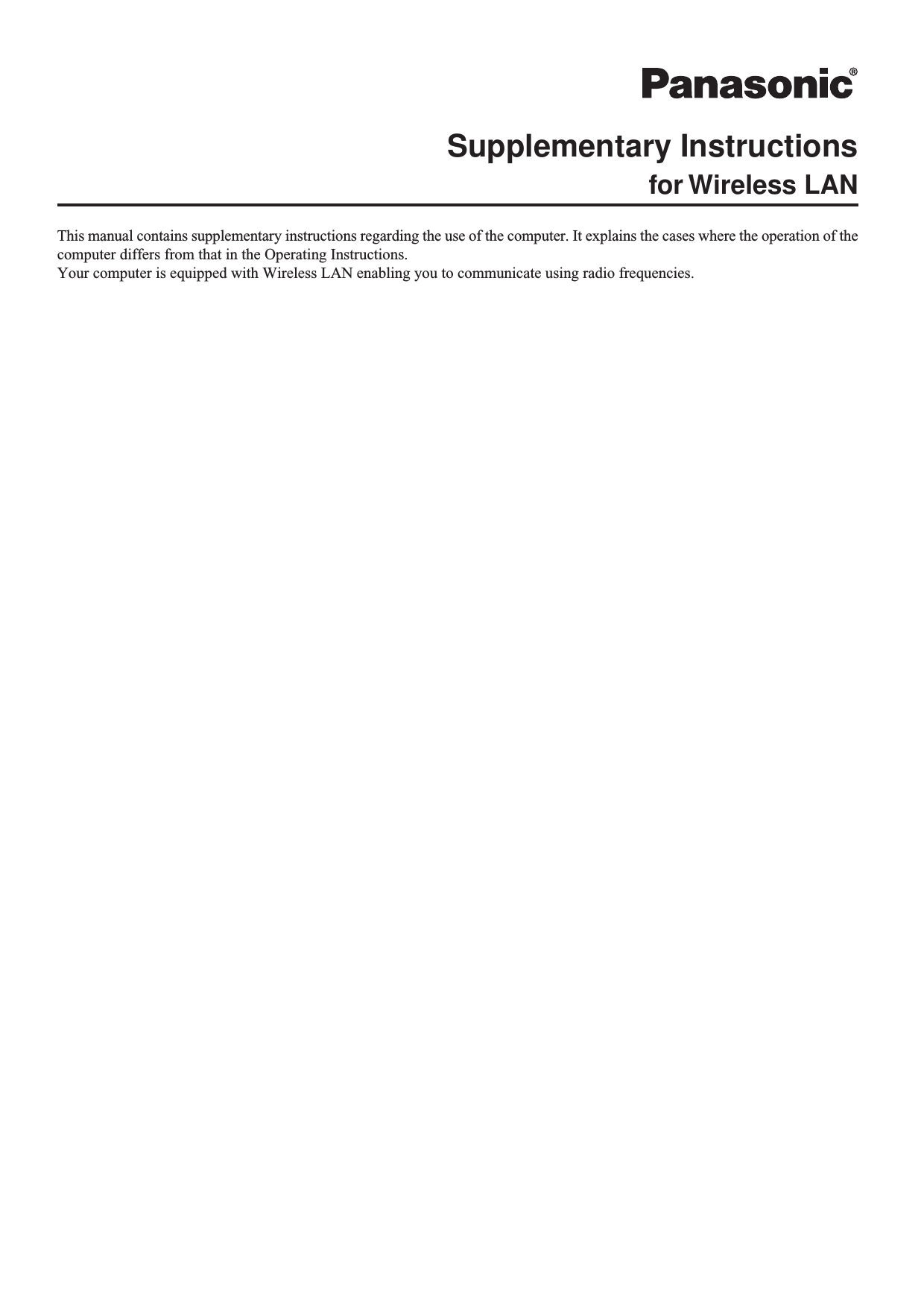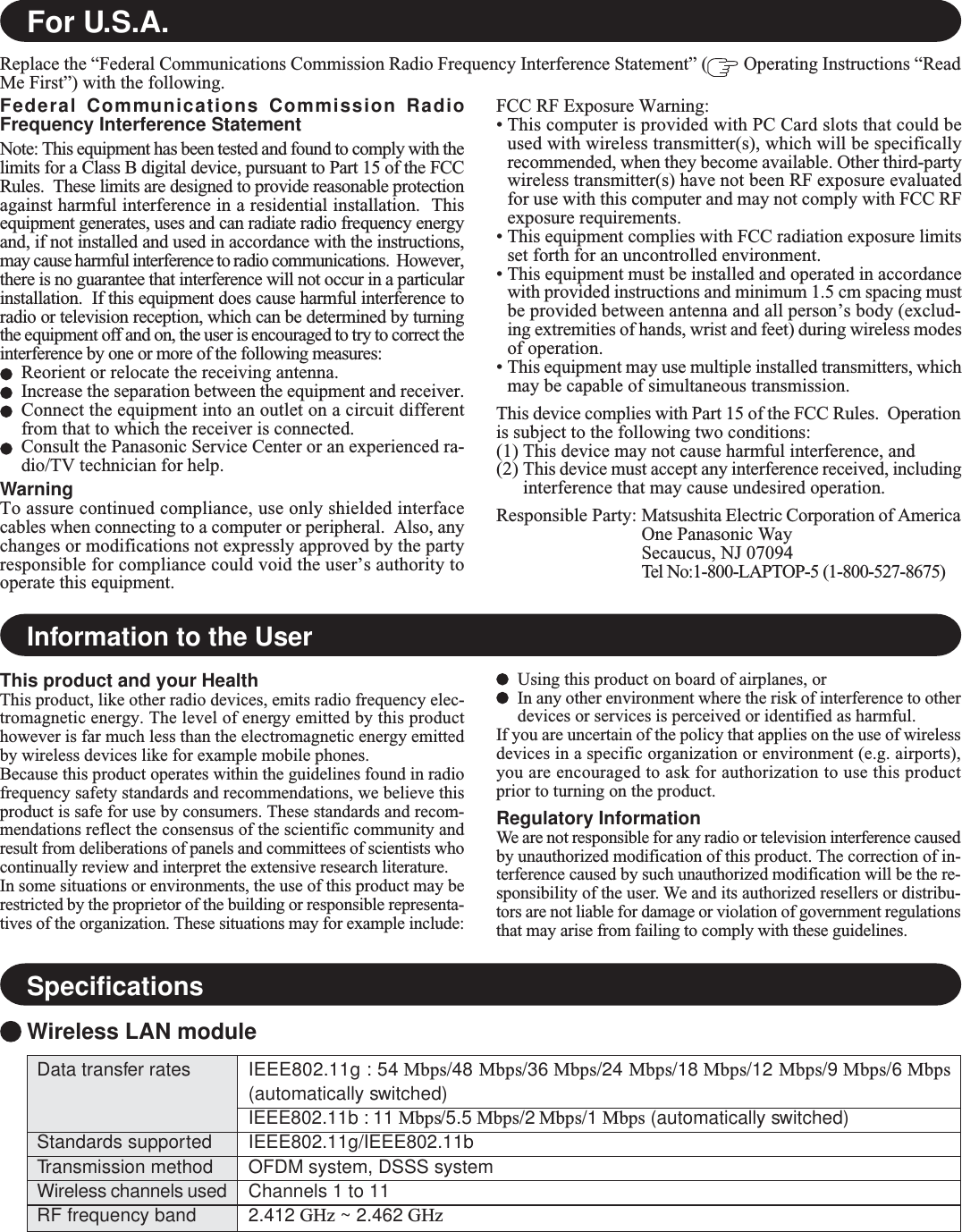Panasonic of North America 9TGCF-294 Panasonic Toughbook w/ Intel WLAN & Alps Bluetooth User Manual Part 2
Panasonic Corporation of North America Panasonic Toughbook w/ Intel WLAN & Alps Bluetooth Users Manual Part 2
Contents
- 1. Users Manual Part 1
- 2. Users Manual Part 2
- 3. Users Maunal Part 1
Users Manual Part 2


![3Wireless LANIf you use a wireless LAN, you can use a network without cable connections.CAUTIONzCommunication is performed through the wireless LAN antenna. Do not block the antenna area with your hand or otherwise interfere with the passage of the radio signals.NOTEzThe communication speeds and distances differ depending on the devices that support the wireless LAN, the installation environment and other ambient conditions.zOne characteristic of radio waves is that their transmission rate tends to drop as the communication distance increases. It is recommended that the devices supporting the wireless LAN be used in close vicinity to each other.zThe rate may drop while a microwave oven is being used.Windows XPzDo not use the Fast User Switching function.Do not use wireless LAN on airplanes, in hospitals, or in other locations where wireless LAN signals may affect the operation of devices in the vicinity.zIf you intend to use the computer in the environments described above, turn the wireless LAN off using the following method:1Double-click or on the taskbar.2Select your wireless LAN adaptor and select [General].3Select [Off] for [Switch radio].4Select [OK].The icon will turn to .Precautions](https://usermanual.wiki/Panasonic-of-North-America/9TGCF-294.Users-Manual-Part-2/User-Guide-413572-Page-3.png)
![4Wireless LANTo prevent theft of data or unauthorized access to the hard disk via a wireless LAN.z If you plan to use wireless LAN functions, we recommend that you do so only after making the appropriate security settings, such as for data encryption.We recommend turning the wireless LAN off when it is not used or out of range.zIf you leave the wireless LAN on, the battery's operating time is shortened.To use the wireless LAN, set the profile using the following procedure.The settings will vary for different network environments depending on the network system being used. For more details, ask your system administrator or the person in charge of the network.CAUTIONzSet profiles for each user using the following procedure.NOTEWindows XPzIf [Windows XP is currently configured to manage the Intel(R) PRO/Wireless LAN adaptor.] is displayed, select [Yes].Windows 2000zAfter setting the profile, delete the profile displayed at the time of purchase (profile name: Default).1Double-click on the taskbar.2Select your wireless LAN adapter and select [General].3Select [On] for [Switch radio].The Settings](https://usermanual.wiki/Panasonic-of-North-America/9TGCF-294.Users-Manual-Part-2/User-Guide-413572-Page-4.png)
![5Wireless LAN4Select [Networks] and select [Add]. 5Enter the profile name and network name (SSID), and then make other necessary changes, then select [Next].6Make necessary changes and select [Finish].7Select [OK].NOTEzAbout WLAN Security ClientWLAN Security Client is an implementation of the client side of the IEEE 802.1X-Port Based Network Access Control protocol. • Since the WLAN Security Client has already started when is displayed on the taskbar, do not double-start it. If is not displayed, start up the WLAN Security Client in the following menu.Windows XPSelect [Start] - [All Programs] - [Intel] - [WLAN Security Client Manager].Windows 2000Select [Start] - [Programs] - [Intel] - [WLAN Security Client Manager].• For more information about how to use the WLAN Security Client, refer to [Help] in the menu bar or;Windows XPSelect [Getting Started Guide] or [User's Guide] in [Start] - [All Programs] - [Intel].Windows 2000Select [Getting Started Guide] or [User's Guide] in [Start] - [Programs] - [Intel]. Select or on the taskbar to check the communication status.For more information about how to use the Intel PROSet, refer to [Help] in the menu bar.Check the Communication Status](https://usermanual.wiki/Panasonic-of-North-America/9TGCF-294.Users-Manual-Part-2/User-Guide-413572-Page-5.png)
![6Wireless LANIf the function fails to operate correctlyRead the operating instructions for the access point carefully and check the settings.The access point fails to be displayed in [Available Networks]zSelect the profile you are using, and select [Advanced] in [Networks]. [Connect to ad hoc networks only] may have been selected in [Connection preference]. In this case, select [Connect to infrastructure and ad hoc networks].zThis computer uses channels 1 through 11*1. Check the channel being used.*1 In the case of wireless communications, the frequency band being used can be divided into segments, so that different communications can be conducted on each band segment. A "Channel" refers to the individual frequency bandwidth divisions.The access point cannot be accessedzThe network key setting may not conform to the access point.Check the network key setting of the access point and, if necessary, set it again correctly.zDepending on the access point and settings, access may not be accepted unless the computer's MAC address is registered beforehand. In this case, check the computer's MAC address using the following procedure and register it according to the operating instructions of the access point.1Display [Command Prompt].Windows XPSelect [Start] - [All Programs] - [Accessories] - [Command Prompt].Windows 2000Select [Start] - [Programs] - [Accessories] - [Command Prompt].2Input [ipconfig /all], and press Enter.3Make a note of the 12-digit string of alphanumerics displayed on "Physical Address" line on Wireless LAN side. Then input [exit], and press Enter.The IP address of the access point is wrongzFollowing the operating instructions of the access point, set the IP address of the access point again correctly.](https://usermanual.wiki/Panasonic-of-North-America/9TGCF-294.Users-Manual-Part-2/User-Guide-413572-Page-6.png)